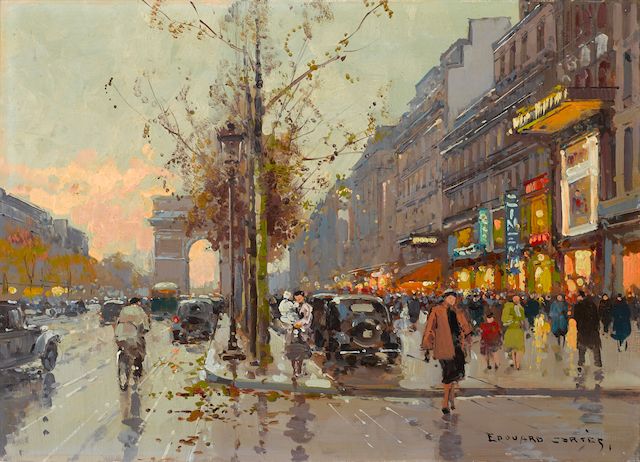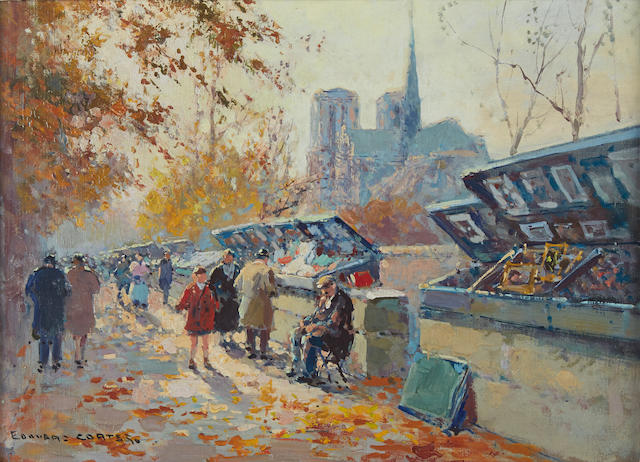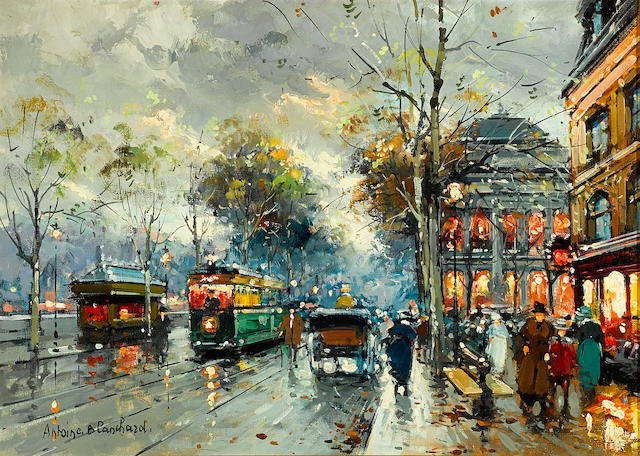
Gustave Loiseau, 1865 - 1935
Rue Clignancourt, Paris, on 14th July, ca. 1925
Oil on canvas
23 7/8 by 19 5/8 in., 60.8 by 50 cm El Museo Nacional Thyssen-Bornemisza
Here Gustave Loiseau chose to paint an area of Paris he had been familiar with for a long time. In 1887, when he had decided to devote himself to painting, Gustave Loiseau had settled in Montmartre, in rue de Ravignan. Rue Clignancourt is only a few steps away, at the foot of the hill it borders to the east. To describe it, the artist placed himself in the corner of the street and of boulevard de Rochechouart, where a brasserie now stands. The area, which is always very busy due to the nearby Tati stores, has changed very little. At the crossroads visible in the foreground, the cars have become more numerous than the strollers, and on the right a newspaper kiosk has replaced the old roundabout.
But here again we can appreciate the precision with which the artist observed and recorded the topography of the area. We can easily recognise every detail transcribed on the canvas: the slightly chaotic succession of building façades of different periods and styles, as well as the chimneys and skylights that punctuate the buildings, are immediately identifiable. Flags liven up the scene and dot it with the colours blue, white and red. The crowd has invaded the boulevard, and the bright and clear light is that of a summer day in Paris.
More on this painting
French Post-Impressionist painter Gustave Loiseau is best remembered for his scenes of evocative landscapes and bustling Paris streets. The artist used latticed brushstrokes to depict fleeting moments, blending the Impressionist pursuit of naturalistic depiction with a more modern desire for painterly expression.
Loiseau was born on October 3, 1865 in Paris. In his youth, he was apprenticed to a decorator, but soon received an inheritance from his grandmother, which allowed him to pursue his artistic passions. He enrolled at the École nationale supérieure des Arts Décoratifs, where he studied life drawing, but left after a year after quarreling with an instructor. He set out for the riparian vistas of Pont-Aven, where he befriended other artists including Paul Gauguin and Émile Bernard. There, he developed his signature approach to landscape painting, which involved painting directly from nature (en plein air) and using an idiosyncratic cross-hatching technique (en treillis) to convey subtleties of light and atmosphere. Loiseau took part in the 1890 Impressionists exhibition and from 1893 showed at the Salon des Indépendants. While Paris remained his home and his most frequent subject, he returned to Pont-Aven several times, and also visited coastal Normandy and the various tributaries of the Seine. In the 1920s, he added still lives of flowers, fruits and fish to his repertoire. He died in Paris on October 10, 1935.
Today, Loiseau's work is represented in the collections of the Metropolitan Museum of Art in New York, the Museo Nacional Thyssen-Bornemisza in Madrid and the Tokyo Fuji Art Museum, among many other world institutions.
More on Gustave Loiseau

Jean Béraud, 1849 - 1935
BOIS DE BOULOGNE
Oil on canvas
18 by 23 in., 45.7 by 58.4 cm
Private collection
The Bois de Boulogne is a large public park located along the western edge of Paris. It was created between 1852 and 1858 during the reign of the Emperor Louis Napoleon. It is the second-largest park in Paris, about two and a half times the area of Central Park in New York.
Within the boundaries of the Bois de Boulogne are an English landscape garden with several lakes and a cascade; two smaller botanical and landscape gardens, the Château de Bagatelle and the Pré-Catelan; a zoo and amusement park in the Jardin d'Acclimatation; The Jardin des Serres d'Auteuil, a complex of greenhouses holding a hundred thousand plants; two tracks for horse racing, the Hippodrome de Longchamp and the Auteuil Hippodrome; a tennis stadium where the French Open tennis tournament is held each year; and other attractions. More on The Bois de Boulogne
Jean Béraud (January 12, 1849 – October 4, 1935) was a French painter renowned for his numerous paintings depicting the life of Paris, and the nightlife of Paris society. Pictures of the Champs Elysees, cafés, Montmartre and the banks of the Seine are precisely detailed illustrations of everyday Parisian life during the "Belle Époque". He also painted religious subjects in a contemporary setting.
Béraud became a student of Léon Bonnat, and exhibited his paintings at the Salon for the first time in 1872. However, he did not gain recognition until 1876, with his On the Way Back from the Funeral. He exhibited with the Society of French Watercolorists at the 1889 World's Fair in Paris.
Béraud's paintings often included truth-based humour and mockery of late 19th-century Parisian life, along with frequent appearances of biblical characters in then contemporary situations. Paintings such as Mary Magdalene in the House of the Pharisees aroused controversy when exhibited, because of these themes.
Towards the end of the 19th century, Béraud dedicated less time to his own painting but worked on numerous exhibition committees, including the Salon de la Société Nationale. Béraud never married and had no children. He died in Paris on October 4, 1935, and is buried in Montparnasse Cemetery beside his mother.
More on Jean Béraud

Jean Béraud, 1849 - 1935
LES GRANDS BOULEVARDS (CAFÉ AMÉRICAIN)
Oil on panel
14 1/4 by 21 in., 36.2 by 53.3 cm
Private collection
As a testament to the vital role of the café in Paris society, Johnson’s Universal Cyclopaedia’s 1896 entry for the city carefully described each establishment and its patrons: the “bankers and brokers predominate at the Café Riche; at the Café de Madrid is the headquarters of journalists; actors are numerous at the Café de Suède and the Café des Variétés” while at “the Café Américain congregate literary men and painters” (“Paris,” Johnson’s Universal Cyclopaedia, vol. VI, New York, 1896, p. 442).
Jean Béraud, see above
Jean Béraud, 1849 - 1935
REFUGE, LA PLACE DE L'OPÉRA
Oil on Canvas
13 3/4 by 10 in., 35 by 25.4 cm
Private collection
The Place de l'Opéra is a square in Paris. It was built at the same time as the Opéra Garnier (designed by Charles Garnier), which is located on it, and after which it is named. Both structures were part of the Haussmannian redesign of Paris under Napoleon III of France. More on The Place de l'Opéra
Jean Béraud, see above
Jean Béraud, 1849 - 1935
LE MARCHÉ DES FLEURS À LA CITÉ
Gouache on cardbord
7 7/8 by 12 5/8 in., 20 by 32.1 cm
Private collection
Entirely dedicated to flowers, the Île de la Cité is located on Place Louis Lépine between the Notre-Dame Cathedral and Sainte-Chapelle chapel, the flower market has attracted avid gardeners and curious passers by since 1830. Both covered and open-air, the market is mainly formed by metal pavilion from the 1900s. More on Île de la Cité
Jean Béraud, see above

Edouard Henri Leon Cortès (French, 1882-1969)
L'arc de triomphe
Oil on canvas
13 x 18in (33 x 45.7cm)
Private collection
The Arc de Triomphe de l'Étoile is one of the most famous monuments in Paris, France, standing at the western end of the Champs-Élysées at the centre of Place Charles de Gaulle, formerly named Place de l'Étoile—the étoile or "star" of the juncture formed by its twelve radiating avenues. The location of the arc and the plaza is shared between three arrondissements, 16th (south and west), 17th (north), and 8th (east). The Arc de Triomphe honours those who fought and died for France in the French Revolutionary and Napoleonic Wars, with the names of all French victories and generals inscribed on its inner and outer surfaces. Beneath its vault lies the Tomb of the Unknown Soldier from World War I. More on The Arc de Triomphe
Edouard Léon Cortès (1882–1969) was a French painter of French and Spanish ancestry. He is known as "Le Poète Parisien de la Peinture" or "the Parisian Poet of Painting" because of his diverse Paris cityscapes in a variety of weather and night settings. His father, Antonio Cortés, had been a painter for the Spanish Royal Court.
At the age of 17, Edouard began his studies at the École des Beaux-Arts in Paris. His first exhibition in 1901 brought him immediate recognition.
Although Cortès was a pacifist, when war came close to his native village he was compelled to enlist in a French Infantry Regiment at the age of 32. Sent to the front lines, Cortès was wounded by a bayonet, evacuated to a military hospital, and awarded the Croix de Guerre. After recovery he was reassigned to use his artistic talent to sketch enemy positions. Later in life his convictions led him to refuse the Légion d'Honneur from the French Government. In 1919 he was demobilized.
His works were first exhibited in North America in 1945 and he subsequently achieved even greater success. In his last year of life he was awarded the prestigious Prix Antoine-Quinson from the Salon de Vincennes. More on Edouard Léon Cortès
Edouard Henri Leon Cortès (French, 1882-1969)
La Porte St. Denis
Oil on canvas
13 x 18in (33 x 45.8cm)
Private collection
The Porte Saint-Denis (St. Denis Gate) is a Parisian monument located in the 10th arrondissement, at the site of one of the gates of the Wall of Charles V, one of Paris' former city walls. It is located at the crossing of the Rue Saint-Denis continued by the Rue du Faubourg Saint-Denis, with the Boulevard de Bonne-Nouvelle and the Boulevard Saint-Denis.
The Porte Saint-Denis was originally a gateway through the Wall of Charles V that was built between 1356 and 1383 to protect the Right Bank of Paris. However, with the advent of gunpowder the walls were eventually partly torn down in the 1640s to make way for the larger and more fortified Louis XIII Wall. In the 1670s, the remaining walls of Charles V were entirely demolished when Paris spread beyond the confines of its medieval boundaries.
To replace the old gateway of Porte Saint-Denis, Louis XIV commanded architect François Blondel and the sculptor Michel Anguier to build him a monumental archway that would honor the capture of Franche-Comté in 1668 and the victories on the Rhine during the Franco-Dutch War. Work began in 1672 and was paid for by the city of Paris.
More on The Porte Saint-Denis
Edouard Henri Leon Cortès (French, 1882-1969)
Bouquinistes along the Seine
Oil on canvas
13 x 18in (33 x 45.8cm)
Private collection
Cortès captures the famed booksellers who ply their wares along the banks of the Seine in this oil on canvas. Known as bouquinistes, these booksellers are part of a long tradition that dates back to the 16th century, when market owners lined the famed Parisian river. Today, these booksellers have become a fixture on both the left and right banks of the Seine, thus leading the river to be described as "the only river in the world that runs between two bookshelves." Cortès perfectly evokes the vitality of the quaint atmosphere of these famed merchants, whom he captures on a crisp autumn day. More on the Bouquinistes
Antoine Blanchard (French, 1910-1988)
Le Théâtre du Châtelet
Oil on canvas
13 x 18in (33 x 45.7cm)
Private collection
The Imperial Theater of Châtelet was built between 1860 and 1862 by Gabriel Davioud at the request of Baron Haussmann, at the same time as the current Théâtre de la Ville which faces it on the other side of Place du Châtelet 2, on the site of the old fortress of the Grand Châtelet , which served as a prison and court under the Ancien Régime, and which was destroyed in 1808 during the reign of Napoleon I. The construction, undertaken as part of the transformations of Paris under the Second Empire , led to the removal of several public roads: rue Pierre-à-Poisson, rue de la Saunerie , rue de l'Arche-Pépin and part of rue Saint-Germain-l'Auxerrois . Two new ways were drilled to frame the building: the current rue Édouard-Colonne and the avenue Victoria. More on Le Théâtre du Châtelet
Antoine Blanchard (Marcel Masson) was born in France on November 15, 1910 in a small village near the banks of the Loire. He was the eldest of three children and his father, a carver, managed a small carpentry and furniture shop. Antoine would watch his father hand carve the furniture and began to display an artistic flair early in life - in an effort to promote this talent, his parents sent him to Blois for drawing lessons. He continued his training in Rennes at the Ecole des Beaux-Arts where he studied sculpture and drawing. Upon completion of his studies, he was awarded the schools highest award: Le Prix du Ministre.
By 1932 he left Rennes and traveled to Paris to study. He enrolled at the Ecole des Beaux-Arts and after a few years entered the competition for the Prix de Rome. It was in Paris that he developed a love for the city and it's street life.
Many of the subjects and scenes he portrayed were taken from images he collected of Paris during the 1890's and he would often work on paintings for days or months before he finally felt they were complete.
Like his contemporary, Edouard Cortès, he devoted his artistic career to the depiction of Paris through all its daily and seasonal changes. But he was not an imitator of Cortes, but rather depicted the life of Paris at the turn of the century from his own point of view and with his own, unique style.
Jean Béraud, 1849 - 1935
LA PLACE DE LA RÉPUBLIQUE (NEIGE)
Gouache on paper
8 3/8 by 13 1/4 in., 21.3 by 33.7 cm
Private collection
The Place de la République is a square in Paris. It is named after the French Republic and was called the Place du Château-d'Eau until 1879. As the Place du Château d'Eau, named after a huge fountain designed by Pierre-Simon Girard and built on the site in 1811. La Bédollière wrote that the water came from la Villette and that the fountain was "superb" in character. In 1867, Gabriel Davioud built a more impressive fountain in the square, which (like the first fountain) was decorated with lions. The square took its current shape as part of Baron Hausmann's vast renovation of Paris. Haussmann also built new barracks on the cities, to garrison troops useful in times of civil unrest.More on The Place de la République
Jean Béraud, see above

Eugène Galien-Laloue, 1854-1941
LA PLACE DE LA RÉPUBLIQUE
Gouache on paper
8 1/2 by 12 3/4 in., 21.6 by 32.4 cm
Private collection
The Place de la République, see above
Eugène Galien-Laloue (1854–1941) was a French artist of French-Italian parents and was born in Paris on December 11, 1854. He was a populariser of street scenes, usually painted in autumn or winter. His paintings of the early 1900s accurately represent the era in which he lived: a happy, bustling Paris, la Belle Époque, with horse-drawn carriages, trolley cars and its first omnibuses. Galien-Laloue's works are valued not only for their contribution to 20th-century art, but for the actual history, which they document. His work can be seen at the Musée des Beaux-Arts, Louvier; Musée des Beaux-Arts, La Rochelle; Mulhouse, France. More on Eugène Galien-Laloue
Eugène Galien-Laloue, 1854-1941
LA GARE DE L'EST
Gouache on paper
7 1/2 by 12 1/4 in., 19 by 31 cm
Private collection
Gare de l'Est, ("East station" in English) is one of the six large train termini in Paris. It is in the 10th arrondissement, not far from the Gare du Nord, facing the Boulevard de Strasbourg, part of the north-south axis of Paris created by Baron Haussmann. It is one of the largest and the oldest railway stations in Paris, the western terminus of the Paris–Strasbourg railway and the Paris–Mulhouse railway.
The Gare de l'Est was opened in 1849 by the Compagnie du Chemin de Fer de Paris à Strasbourg (the Paris-Strasbourg Railway Company) under the name "Strasbourg platform." This platform corresponds today with the hall for main-line trains, and was designed by the architect François Duquesnay. It was renamed the "Gare de l'Est" in 1854, after the expansion of service to Mulhouse. More
Eugène Galien-Laloue, see above
Please visit my other blogs: Art Collector, Mythology, Marine Art, Portrait of a Lady, The Orientalist, Art of the Nude and The Canals of Venice, Middle East Artists, 365 Saints and 365 Days, also visit my Boards on Pinterest
Images are copyright of their respective owners, assignees or others.
Some Images may be subject to copyright
I don't own any of these images - credit is always given when due unless
it is unknown to me. if I post your images without your permission, please tell
me.
I do not sell art, art prints, framed posters or reproductions. Ads are
shown only to compensate the hosting expenses.
If you enjoyed this post, please share with friends and family.
Thank you for visiting my blog and also for liking its posts and pages.
Please note that the content of this post primarily consists of articles
available from Wikipedia or other free sources online.















No comments:
Post a Comment